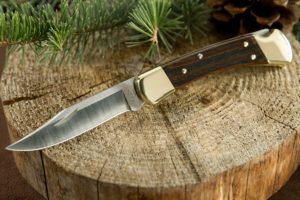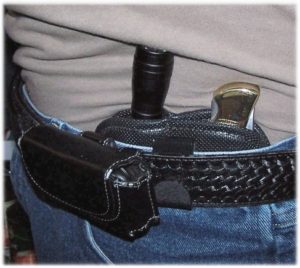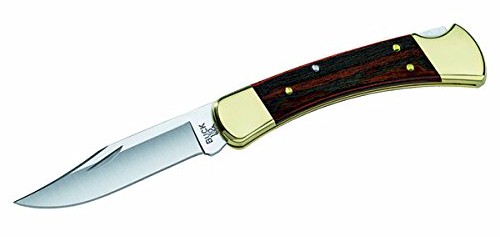On April 18, 1963, just two years after their incorporation, the Buck board of directors voted to authorize development of a new folding utility and hunting knife. The new design featured a sturdy locking mechanism and a substantial clip point blade suitable for butchering and skinning large game. This would become the world-famous Buck Model 110 Folding Hunter.
The Buck Model 110 has a 3 3⁄4–inch blade, a high-tension lock and a low-pressure release, the handles are typically wood and the bolsters are made of heavy-gauge brass. Introduced in 1964, the Buck Folding Hunter was one of the first lock-back folding knives considered strong enough to do the work of a fixed-blade knife. Its debut revolutionized hunting knives, rapidly becoming one of the most popular knives ever made, with some 15 million Model 110 knives produced since 1964. Before 1981, the specially heat-treated stainless steel used was 440C, from 1981 to 1992 it was 425M, and after 1993 Buck has used 420HC stainless steel. Its design is one of the most imitated knife patterns in the world.
– Courtesy of https://en.wikipedia.org/wiki/Buck_Knives
The Buck 110 Folding Hunter has been carried in sheaths, pockets, tool boxes, and hunting and tackle boxes for many years by many people. Even today, with the plethora of “tactical” and “open-assist” folding knives on the market, the Buck 110 Folding Hunter still remains a favorite of a lot of people – including me.
I carried a Buck 110 Folding Hunter in a leather pouch before and during my “biker” days, as it was the most commonly expected knife to carry. When woods-walking or camping, the Buck 110 Folding Hunter was always there with my Air Force Survival Knife.
As a one-time cutlery shop owner, operator, and sharpener of edged devices I can attest to the quality of steel used in Buck knives and also the knife’s shortcomings. The sharpened edge was long lasting as were the knives – unless you used them to pry. The blade, while excellent for cutting, was simply too brittle for prying and I saw my share of broken blades (usually at the tip). In some cases, I could reform the blade and the knife would continue on to serve its owner. In some cases, the blade was beyond redemption and the break was too far back on the blade. However, I would do trade-ins for my customers who wanted a new knife. I would accept a trade of a broken Buck 110 for a new knife of the customers choosing and would reduce the cost of the new knife to an agreeable sum of money. The Buck 110 was then sent back to the factory for reconditioning. They always came back like they were brand new, as Buck has an excellent warranty, but use and abuse is not covered and it would cost me a nominal amount of money to have the knife restored to its original condition. I would say that it was worth the effort, though. I sold quite a few “reconditioned” Buck 110 knives at a better than reasonable cost.
Somewhere along the line, my Buck 110 was lost and never replaced for some reason. The cutlery shop was closed, the “biker” days were over, and my attention went elsewhere. A Buck Model 112, with its three inch blade and finger grooves, and which was better suited for carry in the pocket, replaced the Buck 110 for many years until the 112 was lost. I opted for a different brand of knife with a pocket-clip and have gone through many of them over the years. The Gerber “FAST” knife is one that I carry today.
 I was watching the series “Longmire” and in one scene he pulled out his “working” knife, which I realized very quickly was a Buck 110 Folding Hunter. Pangs of want soon followed. It was one of those, “If I run across one for a good price, I’ll get it” moments, however. Recently, I was in a local sporting goods store and I came upon a Buck 110 Folding Hunter for a very good price as I was perusing other knives in the display. For the price showed, the Buck 110 Folding Hunter came home with me. Now, I have other knives; some I kept when I closed the cutlery shop down and others have been purchased since that time, but I felt as if I had brought an old friend home with me with the Buck 110 Folding Hunter.
I was watching the series “Longmire” and in one scene he pulled out his “working” knife, which I realized very quickly was a Buck 110 Folding Hunter. Pangs of want soon followed. It was one of those, “If I run across one for a good price, I’ll get it” moments, however. Recently, I was in a local sporting goods store and I came upon a Buck 110 Folding Hunter for a very good price as I was perusing other knives in the display. For the price showed, the Buck 110 Folding Hunter came home with me. Now, I have other knives; some I kept when I closed the cutlery shop down and others have been purchased since that time, but I felt as if I had brought an old friend home with me with the Buck 110 Folding Hunter.
The locking/unlocking mechanism can be extremely stiff when the knife is new. I remember spending a lot of time with the one that I previously owned getting the blade to “flip out” and lock at a certain point. I am not so willing to spend that time these days and I carry another knife that allows me deploy the blade quickly if need be. I also carry a fixed-blade knife and there is no “blade-flipping” at all.
When new, the blades of most knives sold these days are sharp, but they are not truly sharp. A few swipes of the blade on a good stone made the edge of the Buck 110 Folding Hunter’s 420HC steel edge “truly” sharp.
 After modifying a Remora double accessory case (https://guntoters.com/blog/2015/08/09/remora-dual-accessory-holder-iwb-modification/) for carrying spare magazines, I had ordered a second for the same modification but had not put it to use. With the Buck 110 Folding hunter; however, that condition soon changed. Now, the Buck 110 Folding Hunter resides in one pouch while one of my favorite flashlights resides in the other pouch. The second “FrankenMora” is now carried IWB on my offside with its contents (the Buck 110 and flashlight) while the first “FrankenMora” is carried strong-side with two spare magazines for my EDC.
After modifying a Remora double accessory case (https://guntoters.com/blog/2015/08/09/remora-dual-accessory-holder-iwb-modification/) for carrying spare magazines, I had ordered a second for the same modification but had not put it to use. With the Buck 110 Folding hunter; however, that condition soon changed. Now, the Buck 110 Folding Hunter resides in one pouch while one of my favorite flashlights resides in the other pouch. The second “FrankenMora” is now carried IWB on my offside with its contents (the Buck 110 and flashlight) while the first “FrankenMora” is carried strong-side with two spare magazines for my EDC.
Folding knives have been around for a long time. American-made folding knives are highly desirable and a few companies still remain in existence. Although the Buck 110 Folding Hunter is made in the U.S.A., the pouch is made in Mexico. I place my Buck 110 Folding Hunter in another U.S.A. made product – the Remora double accessory pouch, but I leave carry preferences totally up to you.
The Buck Forever Warranty is very strong, and it has limitations, but Buck is always conscious of its customers.
We warranty each and every Buck knife to be free of defects in material and workmanship for the life of the knife, and we will repair or replace with a new Buck knife, at our option, any Buck knife that is defective. Buck Knives does not warrant its products against normal wear, misuse, or product modifications. Buck Knives are not intended to be used as hammers, chisels, pry bars or screwdrivers. If your knife was damaged due to misuse, our repair department can analyze the damage and repair it for a reasonable fee. If your knife is unable to be repaired, we will extend a one- time courtesy offer, allowing you the option to purchase a new knife for 50% off of our MSRP price listed on the website, excluding any custom knives or web specials.
As far as I am concerned, it just feels good to have an old friend on his side – literally.
Aside from the Buck 110 Folding Hunter, Buck also has a wide variety of products. A Buck 118 Personal Knife still resides in the knife collection and is one of my favorite knives. After being in the cutlery business, sharpening knives (and a few swords), and making some of my own knives, I am a little picky about what knives I will own. Buck knives are part of the American tradition and ownership of quality knives for the everyday working man, the hunter, the tactical type, and the survivalist.
Whether you are a traditionalist or not, perhaps you should get acquainted, or re-acquainted with the Buck line of products.
![]()


